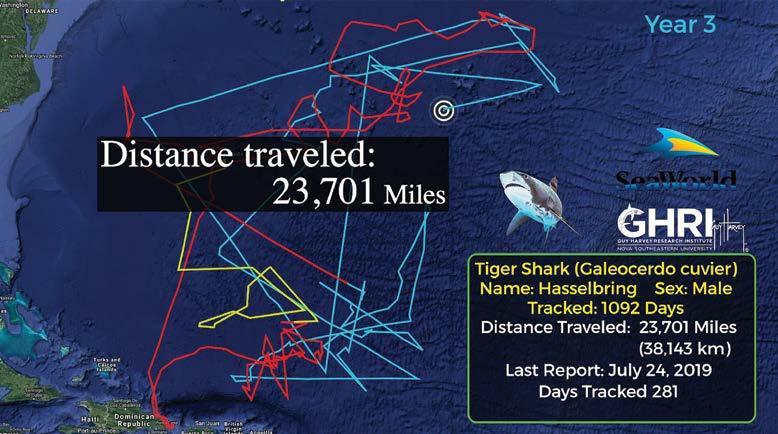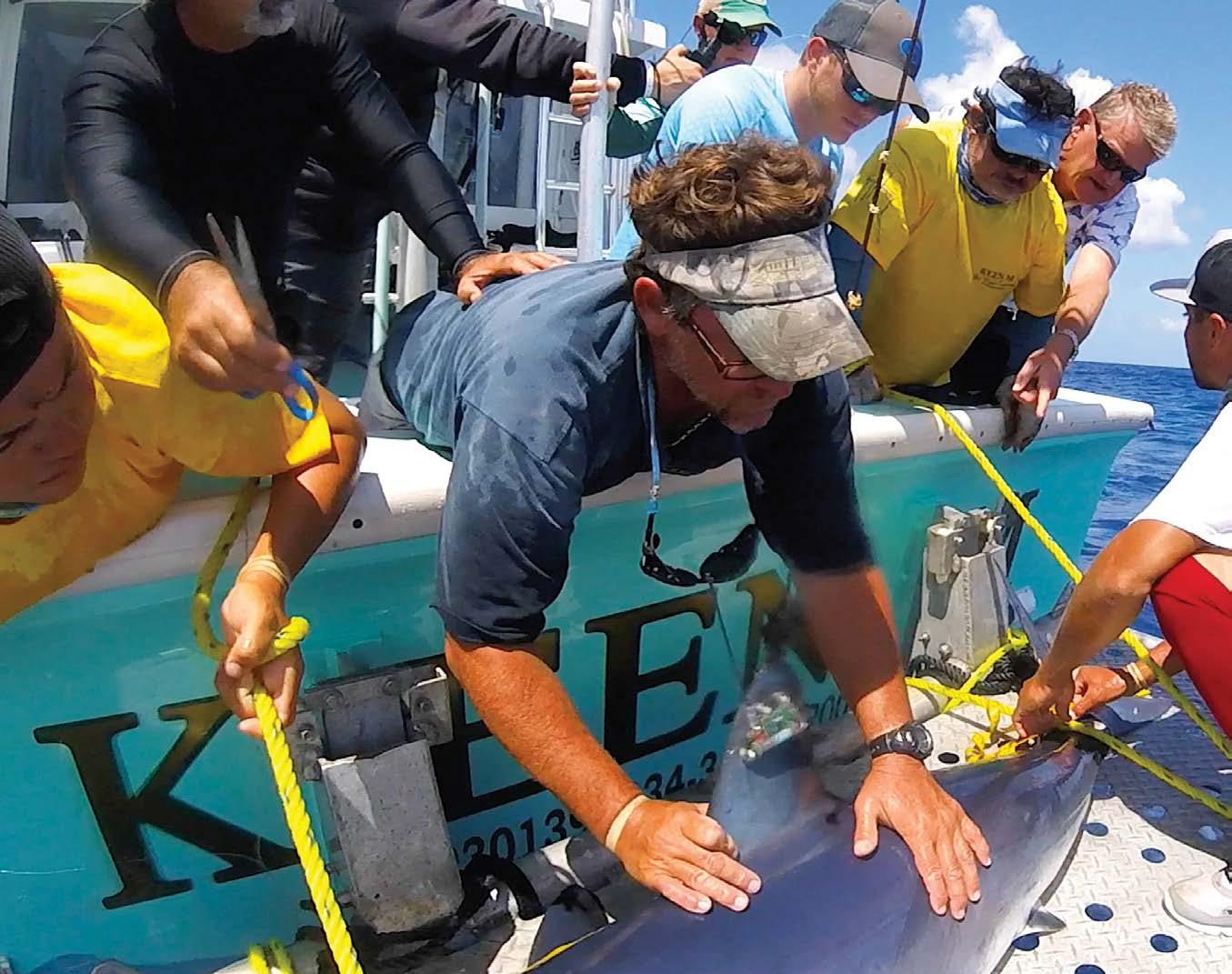
9 minute read
Making Tracks
spotted (so to speak) on GHRITracking.org. If you check out the tiger shark tracking section on the website, you will see all of the tagged tigers. This project revealed groundbreaking information and led to the documentaries This is Your Ocean Sharks and Tiger Shark Express. Because the Bahamas turned out to be such a key migratory hub for tiger sharks, the island nation moved to protect them on July 5, 2011.
Through the tracking, Dr. Shivji and Dr. Wetherbee determined that tiger sharks are as at home in the open waters of the Atlantic as they are on a Caribbean coral reef, and they discovered that tiger sharks are basically snowbirds. They winter in the warm tropical Caribbean waters and summer in the cooler waters around Bermuda. Tiger sharks are capable of returning to the exact spot after traveling thousands of miles year after year.
This groundbreaking research was only made possible through the tagging of the sharks and the information generated by GHRITracking.org.
OCEANIC WHITETIP SHARKS The other incredible tracking project I was a part of was tagging oceanic whitetip sharks (OWT). Probably one of the most difficult tracking projects of all. The fins of these open ocean travelers used to dot the surface of remote oceans around the world, following boats and quickly investigating anything entering their blue world. Known as the “shipwreck shark,” they are usually the first to arrive when a ship sinks on the high seas. Because of their curious nature, overfishing and bycatch, scientists estimate that these sharks have been annihilated from our planet, with populations reduced by as much as 99%.
To tag OWTs, we were on the Shear Water again with Jim Abernathy, Guy Harvey, Dr. Shivji and Dr. Wetherbee. Our mission would take us to Cat Island in the Bahamas, a 36-hour voyage taking us through The Exumas, and the island of Big Spot Major, inhabited by swimming pigs.
The oceanic whitetip has to be one of my favorite sharks; it is highly interactive and always right in front of your camera when filming. They are easy (in an adrenaline-packed way) to work with. For these sharks, you’d attract them to the boat using Jim’s floating island of bait, and then drop in a baited hook. The shark is then pulled to the boat, and the SPOT Tag is placed on the dorsal fin.
Again, these are always the hardest sharks to find and tag because they’ve been so wiped out. From the Bahamas, we moved our efforts to the Cayman Islands and worked to tag these sharks. The Guy Harvey Ocean Foundation also enlisted the help of fishing tournaments. If an angler had an oceanic on the line, they would be given prize money for turning the shark over to be tagged. It was a creative plan that allowed us to have more eyes on the water to find this elusive animal.
If you track an oceanic whitetip on GHRITracking.org, you’ll see their migrations from Cat Island and Grand Cayman. Still one of my favorite sharks.
Bahamas


SHORTFIN MAKO SHARK The next species, the shortfin mako shark, took us from the waters off the coast of the Yucatán to Ocean City, Maryland. We traveled to Mexico almost a dozen times to work with and tag these sharks. Our base of operations was Isla Mujeres, a tiny idyllic island off the coast of the Yucatán. Our captain for these missions was Anthony Mendillo.
During the first several years of tagging makos, we would jump in to film the release, and we would get amazing pictures and images — that is until the shark we named Tough Guy showed up. In our shortfin mako shark tagging process, we would spend hours trolling with a variety of lures behind the boat (including wooden boards painted and cut to look like dolphin fish). Once we had a mako shark in the spread, we would hand toss a bait, get in on the hook and bring it to the back of the boat. Once on board, the shark would be tagged and released.
Guy would revive each shark by getting in the water and literally push it through the water for a few minutes. When the shark started to swim on its own, he would release it. After tagging some sharks by bringing them on the boat through the tuna door (a little dicey when you mix together rough seas and sharp teeth), it was decided to build a table at the back of the boat to tag the shark there. That would give the scientists plenty of room to work on the shark and then quickly release
it. We felt we had a pretty good workflow until Tough Guy. This shark was caught, brought onto the shark table and tagged. We released him and Guy swam to revive him. Eventually, he released Tough Guy and I went in to film the departure, except, it didn’t really go according to that plan.
Tough Guy decided to come back directly at me, hitting my camera — hard. Something told my gut that he was going to go after Guy next, and as I swam to warn Guy, Tough

Right: Mako shark tagging in Isla Mujeres. Below: Dr. Guy Harvey pushes the shark named “Tough Guy” through the water after the tagging process.

Isla Mujeres
Marine biologist Rafael De La Parra helps tag a whale shark in the wild.

Guy got there first. Guy swatted the shark away with a GoPro Hero on an extension pole. After that, Tough Guy left as our hearts pounded. His message was clearly delivered, “leave me alone.”
The reporting from his tag was incredible. Tough Guy left Mexico and traveled all the way to Nova Scotia. The memory of Tough Guy will always be indelible. In fact, my dog, a pandemic pooch rescue, is named after Tough Guy (Mako Monday Tough Guy).
The year after our experience with Tough Guy, we added a shark cage to our expeditions. The thinking was that we could get as close to the sharks as we wanted, getting great images in the process, and we could do it safely.
SeaWorld has always been a great supporter and partner in these expeditions; if you’re ever in Orlando at SeaWorld, you can track GHRI sharks on kiosks in the Shark Realm. There’s a video of Tough Guy in the queue as you wait to ride the Mako Roller Coaster.
SAILFISH It’s not as exciting as Tough Guy, but I’d be remiss if I didn’t talk about all of the sailfish we tagged in Isla Mujeres. You can find those tracks on GHRITracking.org as well. We worked with sailfish for several years with Dr. Molly Lutcavage of the Large Pelagics Research Center.
Her work with bluefin tuna and sailfish is remarkable. We put PSAT (Pop-Off Satellite Archival Tags) on sailfish while fishing off the coast of the Yucatán. One year, we tagged a total of 11 sailfish in a day, but the highlight had to be a beautiful shot of Anthony’s daughter Lilly seeing a sailfish on its way to the open ocean.

The effort was to better understand how this prized game fish travels through the Gulf of Mexico — even as far south as French Guiana and back to the Yucatán — and the tracks proved that sailfish were prolific travelers around the Gulf of Mexico.
WHALE SHARKS Tiger sharks, mako sharks, oceanic whitetips and sailfish are all amazing and inspiring, but nothing could quite prepare me to watch the process of tagging whale sharks. Each year, these bus-sized creatures travel to the waters off the coast of the Yucatán Peninsula to feed on a variety of tiny creatures. You can set a calendar by it.
Marine biologist Rafael De La Parra has done a lot of work with these impressive animals. You can’t stop an animal that’s more than 27 feet long from swimming, so Rafael swims alongside the shark, with an air-powered drill (powered from his SCUBA tank). As he saunters along with the shark, he puts in the tag one screw at a time. It’s mesmerizing to watch.
Just in case you don’t know, whale sharks are filter feeders so they don’t have rows of potentially flesh ripping teeth like makos and tigers. Whale sharks are more like giant puppy dogs of the sea — gentle and tolerant of human visitors.
The sharks return to the waters annually with such regularity that a few of the sharks, Rio Lady and Milo, have even been tagged twice. Rio Lady has traveled more than 850 miles, and that’s just with the tag that was put on in 2018. Before that, she was tagged in 2007. She traveled all the way to the southern Atlantic Ocean near the Saint Peter and Saint Paul Archipelago, located between Brazil and West Africa. Rio Lady proved that the paths these creatures travel over decades are unique. Rio Lady’s story was so fascinating that it was picked up by media around the world. In this edition of Guy Harvey Magazine, you will also see the incredible track of Milo, another whale shark tagged twice.
From tiger sharks to whale sharks, it’s been an incredible journey over these past 10 years, with dozens and dozens of expeditions needed to make something like GHRITracking.org happen. In that time, the scientists at the Guy Harvey Ocean Foundation and the Guy Harvey Research Institute have proven these pelagic creatures are truly international animals.
Another useful tool of GHRITracking. org is that it has a filter that shows Exclusive Economic Zones, so you can see how these creatures pass through the waters of one country to another. While the sharks know no boundaries, we need to know where they travel so all countries can work to protect them and ensure that these creatures will be around for the future.
When we see the planet as one, as the pelagics do, we too will do a better job of protecting all of the creatures who live on this planet with us. I think the best place to witness this in real time, from the comfort of your home, is GHRITracking.org.

George C. Schellenger has worked with the Guy Harvey Ocean Foundation since 2008 and has worked on expeditions with Guy Harvey and the Guy Harvey Research Institute since 2010. He is an Emmy Award-winning producer. If you want to know more of the story behind all of the tracks on GHRITracking.org, check out Guy Harvey Expeditions on Amazon Prime. Just ask your Alexa-enabled device to “show me Guy Harvey on Amazon.com.”











